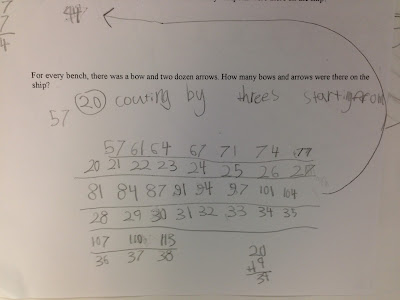Being a small, private school for gifted students, Seabury School has the luxury of truly differentiating in Math. To better accommodate the various students' needs, the Navigators (first graders) and the Gemstones (second graders) have Math at the same time and are given small group instruction
from the first grade level to the fifth!
"Education with the breaks off!" as our website says.
(I.e., there is no ceiling to how far the students can go.)
We also have the freedom to incorporate our various topics of study into Math. We purposefully do this several times a month when all the students come together for a
MATH ADVENTURE!
Our Math Adventures are designed with some of the following in mind:
- The students will become real life math problem solvers.
- The students will work collaboratively and learn from each others' ideas and each others' successes and mistakes.
- Open-ended problem solving will stretch the students' brain muscles and increase their mathematical thinking skills.
- The students will learn to embrace thinking outside the box and learn how problems can be solved in a variety of ways.
- The students will discover that math is useful and is great fun!
Here are some pictures of our recent Math Adventure called "Viking Math Adventure."
We've been studying the Viking explorers as an introduction to our study of explorers. We began our lesson with a look at several Viking boats that have been unearthed in Scandinavia.
We then were given the task of figuring out several things:
(derived from http://www.viking.no/e/problems/ematteb.htm)
Some students worked on the strategy of "draw a picture" to figure out:
- how many oarsmen were on the boat.
- how many weapons were there in all if each had a sword, a spear and an axe.
Several of them had not had multiplication before and were automatically using skip counting and repeated addition.
Others were given more complex problems such as:
- For every bench, there was a bow and two dozen arrows. How many bows and arrows were there on the ship?
- The Oseberg ship is from about the year 835 A.D. It was found in 1880.
- How many years old was the ship when it was found?
- How many years old is the Oseberg ship?
- The ship and its equipment were made of different types of wood. It is estimated that the Gokstad ship was made of 6150 kg of oak, 880 kg of spruce and 225 kg of pine.
- How many kilograms of wood went into the makeup of the ship and its equipment?
- The ships planks were fastened with 150 kg of iron rivets, the anchor weighed 100 kg and the sail and rigging weighed 1000 kg. How much did the ship weigh altogether?
They worked well collaboratively and used the math skills they have learned to figure out the answers.
I overheard in the process:
"I don't think we need an exact answer for this. Let's estimate."
"I think you're right. 2000-800=1200. The boat is about 1200 years old!"
This is exactly what we've been talking about in our regular math class!
Watch out for
the future mathematicians of America
because here we come!












No comments:
Post a Comment